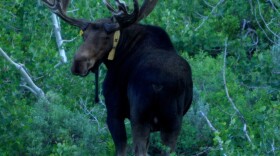The rugged Humboldt-Toiyabe Wilderness, nestled southwest of Austin, is an untamed stretch of Nevada’s backcountry. In this episode of “Outdoor Nevada,” the crew takes a hike with the locals who are maintaining the Toiyabe Crest Trail, just as the Civilian Conservation Corps did in the 1930s.
“I remember my first time in these mountains,” Battleborn Adventures’ Chad Kelly says. Kelly is from the area and one of many people working to revitalize its trail system. “To be able to bring that experience to other people so they can experience that same thing is really why so many of us are out here working on this project. We want to share that and open it up to other people so they can experience the same things.”
While some mountain ranges in Nevada draw crowds for their hiking, the Toiyabe Range caters to those looking to escape. The range offers gems like the towering summit of Arc Dome, a rich history of Nevada’s mining days, and sweeping vistas that capture the state’s basin and range geography.
“It’s truly an amazing experience with a lot of diversity that should be considered for personal experience and use,” U.S. Forest Service Ranger Lance Brown says.
Being five hours from Las Vegas and three and a half hours from Reno, the range offers solitude among its bald ridge lines, making for a perfect side trip when you’re enroute between Nevada’s two largest cities.
If you only have a few hours to enjoy the Toiyabe Range, here’s a hike that will allow you to experience its variety.
Route: Toiyabe Crest Trail via Ophir Canyon. Ophir Creek Canyon was home to the town of Ophir and about 400 people back in 1863. Today, all that remains of Ophir are the ruins of its mining history. Old mines, saloons, and stone houses are littered along the canyons, hills, and along the main path of Ophir Canyon Road. Farther up the canyon, the markers of the past begin to dissipate, and the wilderness of the Toiyabe Range reappears.
Getting there: The best approach to Ophir is from Reno or Las Vegas. Both ways will lead you to NV-376.
From Reno: Head east on I-80 E toward Fernley. Then take exit 48 for US-50 Alt toward Silver Springs/Fallon and continue on US-50 Alt for about 31 miles. At Silver Springs, turn right onto US-50 E and follow it for about 90 miles until you reach Austin. Once in Austin, continue on US-50 E until a right turn onto NV-376. From NV-376, continue for 38 miles following signs for the ghost town of Ophir.
From Las Vegas: Head north on US-95 N toward Tonopah, then take US-6 E toward Ely. After a few miles on US-6 E, turn left onto NV-376 N, just before the Tonopah Airport. Follow NV-376 for approximately 67 miles, then turn left onto Ophir Creek Road.
From both directions, a Nevada Historical Marker on the side of the road marks the start of Ophir Canyon Road. This road eventually turns into an unpaved Forest Service road as you enter the canyon. This road is not maintained and is not recommended for any vehicle. Follow the road (on foot) to the remnants of the Ophir ghost town and old mining areas.
Distance: About 3 miles to the ruins (6 miles round trip), About 6 miles to the ridge (about 12 miles round trip).
Equipment Needed: Besides the necessities of hiking in Nevada, such as extra food and water, you will need sturdy clothes that can handle the ruggedness of unmaintained trails. The sagebrush is no joke, and there will occasionally be patches of rough bushwalking along the creeks in the Toiyabe Range. A personal transponder, such as a Garmin InReach, is recommended while exploring this remote region of the state.
Pro Tips: The Toiyabe Range is best hiked from May to October, although I’d argue late fall is the best time to visit. The fall colors and cooler temperatures make exploring this area less about survival and more about enjoying the beauty of this desolate part of the state.









